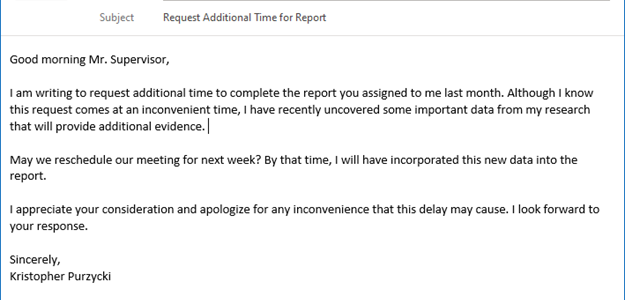22 Introduction: Correspondence and Email
“A letter that is unattractive in appearance leads the reader to feel instinctively that the subject shares this quality.”
~ Harrison McJohnston, Business Correspondence, 1919
Introduction
According to a recent poll conducted by Grammarly (2021), American businesses lose an estimated $1.2 trillion each year due to poor communication practices[1]. The vast majority of business leaders surveyed for the report agree that good communication skills are vital and that candidates’ writing skills are being increasingly scrutinized. In a different study, over 90% of business leaders confirmed that an applicant’s poor writing had hurt their candidacy (Droz & Jacobs, 2019). In other words, writing skills are crucial to the workforce—so much so that those skills help set us apart from the rest of the applicants in today’s competitive job market.
So why is writing so important to business?
Broadly speaking, your writing represents your professional self and your perspective toward the organization you’re writing to or on behalf of. As we’ll discuss in a moment, your attitudes toward the organization you’re writing for, your understanding of your audience’s needs, and even your level of expertise are reflected in how you write. In the business world, your writing expresses a range of values—trustworthiness, honesty, and integrity, to name a few—that potential customers and clients need to perceive to respond positively. This is especially true for writing genres in which professionals must initiate action through direct contact.
Most of this contact happens in emails, letters, memos, as well as text messages. Writing these forms of correspondence makes up the day-to-day work of the business professional: attracting new clients, alerting personnel to new work processes, and promoting new products are just a few functions of correspondence.
Correspondence can be both internal and external. Internal correspondence is writing sent to others within the same organization. These are typically memos, emails, and text messages. The most popular forms of external correspondence sent outside the organization include emails and letters. For example, let’s say I’m the manager of a small business. I have assigned a report to one of my recently hired employees and have scheduled an afternoon meeting with them to review their findings. That is, until I receive this email (see fig. 1):

Although it’s baffling why I would hire someone with the same name, this email is equally confounding! The message is clear: my doppelganger employee is unprepared to discuss their report. While I might be willing to accept this setback as a minor inconvenience, the writing is more troublesome: the informal tone, lack of justification for the delay, and grammar issues present some concerns to me as the manager. Why? After all—they’re just words!
Consider how this message represents the person making the request. The subject line, “Hey,” is incredibly informal (even if it’s addressed to myself) and fails to mention what the email is about. The language I’m using is both grammatically incorrect and oddly casual—especially for someone who is asking their manager for extra time on a report.
There is also an absence of information that helps justify the request. Why does the employee need more time? Why have they waited until the last possible moment to make this request? Based on the closing, “Thanks, bruh,” the employee seems to assume that the delay is approved. The employee also demonstrates a lack of respect for authority—not a good strategy for someone who is asking for extra time to complete an assigned task.
Here is the same email written more professionally (see fig. 2). Notice the difference?

While we all make mistakes, these are not qualities we like to see in the professional environment. Someone who writes carelessly is likely to make mistakes in other work areas. Employees who don’t recognize organizational hierarchies and protocols may not know client relations.
In other words, professional writing is more than words strung together. They’re a reflection of our personalities, values, and skills. In our correspondence, our professional selves come through in our writing.
Why Professional Correspondence is Important
Professional correspondence reflects your professionalism. Correspondence is how we represent our professional selves to our colleagues, customers, and communities. Why does an email to your supervisor take more time than one to a friend? Simply because we recognize our audience, our role, and the level of care we must use in our writing.
These are what we refer to as stakes. For friends and family, the stakes are usually pretty low—our roles are familiar and comfortable. However, the stakes are a bit higher when writing in a professional setting. Linguist Kim Sydow Campbell (2014) speaks to this, noting that “[your] audience determines your reputation based on what you put into that email message. To succeed, you have to be able to predict how they will interpret what you wrote.” Understanding your audience, in other words, is of utmost importance and will help your writing “make sense” as well as determine which roles you must take up.
Professional correspondence needs to make sense. If good professional communication skills are invaluable in the world of business, correspondence is the most prolific genre. Reports, spreadsheets, and proposals are significant. But it is the letter, email, and memo that we use to share ideas, inspire action, and drive relationships. It’s how things get done! Anne Surma (2013) stresses how important it is that professional writing “make sense” (p.21). While this may seem obvious, Surma unpacks this common phrase, describing how complex and significant this task is; in addition to making sense mechanically (grammar, spelling, etc.), professional writing also makes sense in other ways:
- Business sense: is the writing considerate of the organizational impact? Is that email necessary?
- Literary sense: is the writing clear and effective?
- Political sense: does the writing respect the organization’s hierarchy? Does the writing respect the agendas and protocols of the organization and community?
- Rational sense: Is the argument logical and thoughtfully organized?
- Emotional sense: is the tone professional and composed in an appropriate manner?
- Aesthetic sense: does the writing look good? Is it clean and organized?
- Social sense: Does the writing respect the social and cultural expectations of the organization and the community?
These considerations should factor into every work of professional writing and help the writer determine which role—or voice—they must write in.
The professional writer has many roles to play. If “making sense” wasn’t difficult enough, the business professional must also be adept at writing in multiple voices. The foremost reason for this is that so many audiences must be addressed. As Christopher Tribble (2004) studied, written correspondence is the principal form of relationship building, demanding that the professional be able to take on multiple roles (p. 290). If you’re an accountant explaining finances to a client, you’re taking on the role of a guide. To sever ties with a client, you’ll need to take on the litigator role in crafting your disengagement letter.
As another example, consider the social media influencers and how important it is to be attentive to followers’ values and care about dominant trends to develop their audience. Depending on the approach, that influencer might be taking up the role of artist, traveler, model, or activist. When you add video, imagery, and music to the mix, the social media marketer becomes a producer and multimedia editor.
This is why describing those goals clearly in your writing is important. Many of us have exciting, innovative ideas—new concepts, procedures, and inventions we want to make real. The challenge is effectively presenting those ideas in a format that provides direction on making those ideas happen.
If you’re reading this, we can assume you are familiar with emails and text messages. But how often have you written a professional letter? Maybe you’ve written a cover letter, but even those are becoming outdated. It’s even more unlikely that you’ve written memos, an internal form of correspondence that has been displaced by email somewhat but is still a preferred mode of communicating with employees but also a method of record keeping.
This week, we will look at some of the more prominent forms of correspondence in the business world: emails, memos, and cover letters. For each of these, we’ll examine what are known as genre conventions. Simply put, these qualities are associated with different types of media. The genre conventions of a horror movie, for example, include suspenseful music, dark and ominous visuals, and a few surprising moments that might make us jump out of our seats.
Fans of horror movies might also distinguish between different sub-genres. While all share most of these conventions, sub-genres have their own set of conventions that set them apart. Zombie horror, for example, typically features some undead variation, while psychological horror relies more on mental tricks to fool the audience.
For professional writing, it is important to recognize the conventions that distinguish the genre from other forms of communication. The conventions of professional writing include a formal tone and clear, efficient writing free of spelling and grammatical errors.
We’ll look at several sub-genres of correspondence including memos, and cover letters. Each of these has its conventions that make them distinct. Let’s first take a more in-depth look at emails as the most popular form of professional correspondence.
[1] Note: It’s worth mentioning that Grammarly produces tools to help professionals write better. While this doesn’t necessarily mean that these statistics are false, we should recognize that the company has a motivation to research, curate, and present information in such a way that it makes their product look more valuable.

